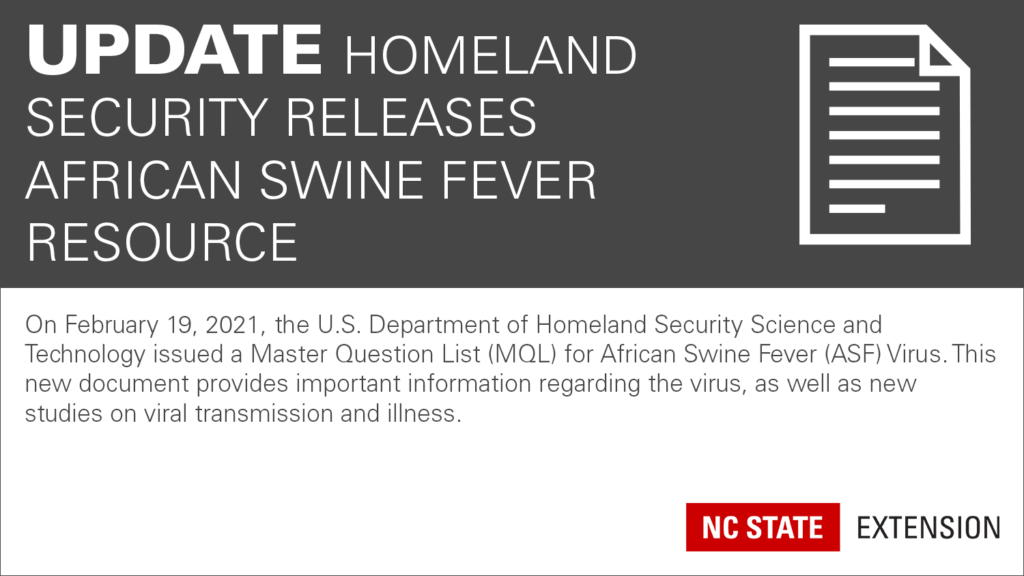U.S. Department of Homeland Security Releases New African Swine Fever Resource
go.ncsu.edu/readext?777498
en Español / em Português
El inglés es el idioma de control de esta página. En la medida en que haya algún conflicto entre la traducción al inglés y la traducción, el inglés prevalece.
Al hacer clic en el enlace de traducción se activa un servicio de traducción gratuito para convertir la página al español. Al igual que con cualquier traducción por Internet, la conversión no es sensible al contexto y puede que no traduzca el texto en su significado original. NC State Extension no garantiza la exactitud del texto traducido. Por favor, tenga en cuenta que algunas aplicaciones y/o servicios pueden no funcionar como se espera cuando se traducen.
Português
Inglês é o idioma de controle desta página. Na medida que haja algum conflito entre o texto original em Inglês e a tradução, o Inglês prevalece.
Ao clicar no link de tradução, um serviço gratuito de tradução será ativado para converter a página para o Português. Como em qualquer tradução pela internet, a conversão não é sensivel ao contexto e pode não ocorrer a tradução para o significado orginal. O serviço de Extensão da Carolina do Norte (NC State Extension) não garante a exatidão do texto traduzido. Por favor, observe que algumas funções ou serviços podem não funcionar como esperado após a tradução.
English
English is the controlling language of this page. To the extent there is any conflict between the English text and the translation, English controls.
Clicking on the translation link activates a free translation service to convert the page to Spanish. As with any Internet translation, the conversion is not context-sensitive and may not translate the text to its original meaning. NC State Extension does not guarantee the accuracy of the translated text. Please note that some applications and/or services may not function as expected when translated.
Collapse ▲On February 19, 2021, the U.S. Department of Homeland Security Science and Technology issued a Master Question List (MQL) for African Swine Fever (ASF) Virus. This new document provides important information regarding the virus, as well as new studies on viral transmission and illness.
What Does This Mean for Animal Food Producers?
It’s important for feed and pet food producers to be aware of the risks associated with their ingredients and products, especially if the end product may end up at a swine farm. Be aware of where your ingredients are sourced from and the final destination of your products. In situations where pet food is diverted to swine farms, be sure any risks associated with the ingredients or food are managed first.
from the MQL:
Transmission via contaminated feed is possible and is dependent upon biosecurity conditions during processing, packing, and transport. Studies show viable virus pathogens in feed and water contaminated by blood can last 30 to 60 days when stored at 4°C, but 1 day in feed and up to 50 days in water when stored at room temperature.
Feed is certainly a concern when it comes to ASF virus transmission. The American Feed Industry Association (AFIA), as well as the Swine Health Information Center, National Pork Board, National Pork Producers Council, and American Association of Swine Veterinarians have also released information regarding biosecurity guidelines for feed manufacturers and viral transmission in feedstuffs.
Read more about the new ASF resource from Feed Strategy.
One of the most important things a producer can do to reduce the risk of viral transmission is to create a robust biosecurity program for its feed mills and farms. Be aware of how traffic flows in and out of the facilities and communicate any biosecurity protocols with incoming visitors.
What Information is Discussed in the Document?
This document provides a comprehensive overview of the current understanding of the ASF virus, including:
- Infectious Dose – How much virus will make a healthy pig ill?
- Transmissibility – How does it spread from one animal to another? How easily is it spread?
- Clinical presentation – What are the clinical signs of an infected animal?
- Incubation period – How long after infection do clinical signs appear? Are animals infectious during this time?
- Biosurveillance and clinical diagnosis – What are the most effective Biosurveillance measures for ASF Virus and methods of confirming infection in individual animals or small herds?
- Viral persistence/Environmental stability – How long does the virus persist in the environment?
- Virus importation – What are the risks of the virus entering the United States through agricultural/food vectors?
- Host range – How many species does it infect? Can it transfer from species to species? What is the vector range (ticks)?
- Medical veterinary countermeasures – Are there effective vaccines and treatments to limit or prevent infection and/or spread?
- Decontamination – What are the effective methods to kill the virus?
- Depopulation and carcass disposal – What are the most effective methods of depopulation and disposal of infected carcasses?
- Swine wastewater treatment on-farm – Is wastewater a significant risk of transmission?
- Personal Protective Equipment (PPE) – Is any PPE necessary to limit spread or protect from decontamination efforts?
- Forensics – Natural vs. intentional use? Test to be used for attribution?
- Genomics – How does the virus compare to previous strains?
For more information on ASF, visit the Pork Checkoff. If you have questions about the impacts of ASF on feed manufacturers, contact Marissa Cohen. For inquiries related to livestock, contact your local livestock agent.



